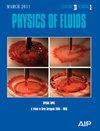Investigation on the lubrication characteristics of low-viscosity lubricated micro-grooved bearings considering turbulence and misalignment
IF 4.3
2区 工程技术
Q1 MECHANICS
引用次数: 5
Abstract
This paper numerically investigates the effect of turbulence and journal misalignment on the lubrication characteristics of micro-grooved bearings with low-viscosity lubricant. The generalized average Reynolds equation satisfying the mass conservation cavitation algorithm is developed by integrating the average flow model proposed by Patir and Cheng, the Ng-Pan turbulent model and the P-Θ model proposed by Elrod and Adams. With this model, the finite difference method is used in the numerical procedure. Moreover, the mathematical models of micro-grooves with different bottom shapes i.e., rectangle, isosceles triangle, left triangle and right triangle are given. The validity of the proposed model is verified by the comparisons with the published literature. Based on numerical simulation, the minimum film thickness, eccentricity ratio, attitude angle, maximum film pressure, friction torque, misalignment moment, film thickness and pressure distributions under different external loads, rotational speeds, radial clearances, misalignment angles and micro-groove parameters between models with and without turbulence and misalignment are comparatively analyzed. The numerical results reveal that turbulence may occur under heavy external load, high rotational speed and large radius clearance. Concurrently, turbulence increases the minimum fluid film thickness and attitude angle, decreases the eccentricity ratio and friction torque, and enhances the bearing capacity. Furthermore, the larger misalignment angle results in the smaller minimum film thickness, eccentricity ratio and attitude angle, and the larger maximum film pressure, misalignment moment and axial tilt of film pressure. Numerical simulations can provide theoretical guidance for the optimization of the geometrical parameters of micro-grooved bearings.考虑湍流和不对准的低粘度润滑微槽轴承润滑特性研究
本文数值研究了湍流和轴颈错位对低粘度润滑剂微槽轴承润滑特性的影响。将Patir和Cheng提出的平均流动模型、Ng-Pan湍流模型和Elrod和Adams提出的P-Θ模型相结合,得到了满足质量守恒空化算法的广义平均Reynolds方程。该模型在数值计算过程中采用了有限差分法。此外,还建立了矩形、等腰三角形、左三角形和直角三角形等不同底形微槽的数学模型。通过与已发表文献的比较,验证了所提出模型的有效性。在数值模拟的基础上,对比分析了不同外载荷、转速、径向间隙、失对角、微槽参数下,有湍流和无失对模型的最小油膜厚度、偏心比、姿态角、最大油膜压力、摩擦力矩、失对力矩、膜厚和压力分布。数值结果表明,在大外载荷、高转速和大半径间隙条件下会发生湍流。湍流增加了最小液膜厚度和姿态角,减小了偏心比和摩擦力矩,增强了承载能力。错向角越大,最小油膜厚度、偏心比和姿态角越小,最大油膜压力、错向力矩和油膜压力轴向倾斜越大。数值模拟可以为微槽轴承几何参数的优化提供理论指导。
本文章由计算机程序翻译,如有差异,请以英文原文为准。
求助全文
约1分钟内获得全文
求助全文
来源期刊

Physics of Fluids
物理-力学
CiteScore
6.50
自引率
41.30%
发文量
2063
审稿时长
2.6 months
期刊介绍:
Physics of Fluids (PoF) is a preeminent journal devoted to publishing original theoretical, computational, and experimental contributions to the understanding of the dynamics of gases, liquids, and complex or multiphase fluids. Topics published in PoF are diverse and reflect the most important subjects in fluid dynamics, including, but not limited to:
-Acoustics
-Aerospace and aeronautical flow
-Astrophysical flow
-Biofluid mechanics
-Cavitation and cavitating flows
-Combustion flows
-Complex fluids
-Compressible flow
-Computational fluid dynamics
-Contact lines
-Continuum mechanics
-Convection
-Cryogenic flow
-Droplets
-Electrical and magnetic effects in fluid flow
-Foam, bubble, and film mechanics
-Flow control
-Flow instability and transition
-Flow orientation and anisotropy
-Flows with other transport phenomena
-Flows with complex boundary conditions
-Flow visualization
-Fluid mechanics
-Fluid physical properties
-Fluid–structure interactions
-Free surface flows
-Geophysical flow
-Interfacial flow
-Knudsen flow
-Laminar flow
-Liquid crystals
-Mathematics of fluids
-Micro- and nanofluid mechanics
-Mixing
-Molecular theory
-Nanofluidics
-Particulate, multiphase, and granular flow
-Processing flows
-Relativistic fluid mechanics
-Rotating flows
-Shock wave phenomena
-Soft matter
-Stratified flows
-Supercritical fluids
-Superfluidity
-Thermodynamics of flow systems
-Transonic flow
-Turbulent flow
-Viscous and non-Newtonian flow
-Viscoelasticity
-Vortex dynamics
-Waves
 求助内容:
求助内容: 应助结果提醒方式:
应助结果提醒方式:


